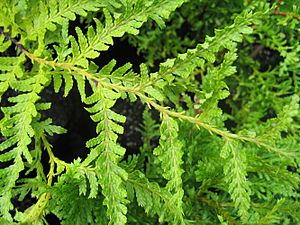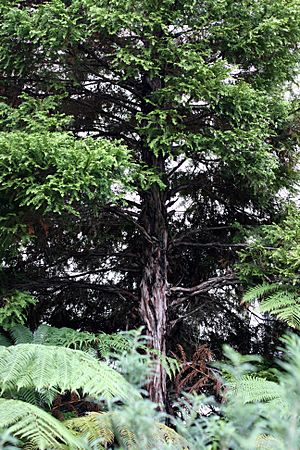Libocedrus plumosa facts for kids
Libocedrus plumosa, also known as the kawaka tree, is a special type of conifer that grows only in New Zealand. It's an evergreen tree, meaning it keeps its green leaves all year round. The kawaka is known for its beautiful, flat, fern-like branches.
Quick facts for kids Libocedrus plumosa |
|
|---|---|
 |
|
| Foliage showing flat sprays | |
| Conservation status | |
| Scientific classification | |
| Genus: |
Libocedrus
|
| Species: |
plumosa
|
Contents
Where Kawaka Trees Grow
The kawaka tree is found only in New Zealand. This means it is endemic to New Zealand, and you won't find it growing naturally anywhere else in the world!
It grows mainly in the North Island, south of 39°S latitude. You can also find it in a few places at the top of the South Island, especially near Nelson.
Kawaka trees like to grow in warm, wet rainforests. They can be found from sea level all the way up to about 600 metres (about 1,970 feet) high.
Sadly, the kawaka is considered a Near Threatened species. This means it could become endangered in the future. Its biggest threat is habitat loss, which happens when its forest homes are cut down or damaged.
What Kawaka Trees Look Like
The kawaka is a tall tree, growing to about 30 to 35 metres (about 98 to 115 feet) high. Its trunk can be as wide as 3 metres (about 10 feet) across! The bark is light brown and peels off in loose, stringy pieces.
The leaves of the kawaka tree are very unique. They are flat and look a bit like scales. These scale-like leaves are arranged in pairs, directly opposite each other on the branches. The smaller leaves on the flat part of the branch are about 1 to 2 millimetres long. The leaves on the sides are a bit bigger, about 2 to 5 millimetres long. This arrangement gives the branches a flattened, fern-like look.
How Kawaka Trees Reproduce
Kawaka trees reproduce using cones, like other conifers. The seed cones are shaped like small cylinders, about 12 to 18 millimetres long. Each cone has four scales. Two of these scales are small and don't produce seeds. The other two are larger and each holds two seeds. Each seed has a small wing, which helps it fly away in the wind.
These seed cones take about six to eight months to fully grow after the tree is pollinated. The pollen cones, which produce the pollen, are much smaller, only about 3 to 5 millimetres long.
Kawaka in Gardens
People sometimes plant the kawaka tree as an ornamental tree because it's so beautiful. You can find it growing in gardens in different parts of the world, including places in the British Isles, like Castlewellan in Northern Ireland.
See also
 In Spanish: Libocedrus plumosa para niños
In Spanish: Libocedrus plumosa para niños



